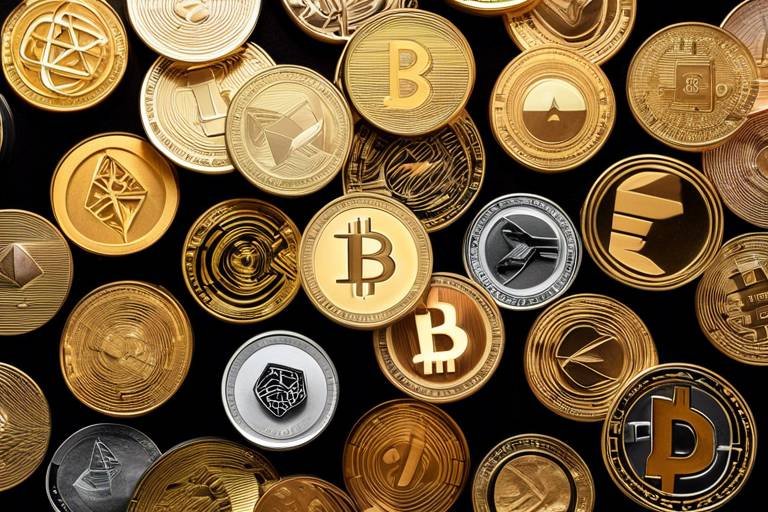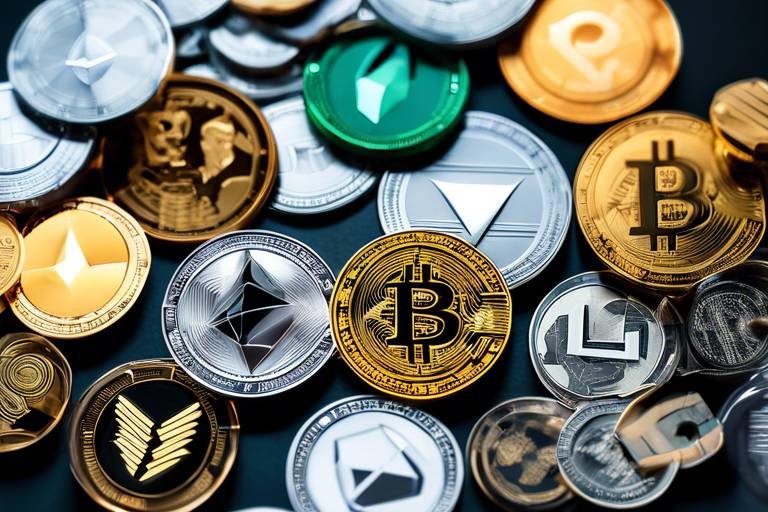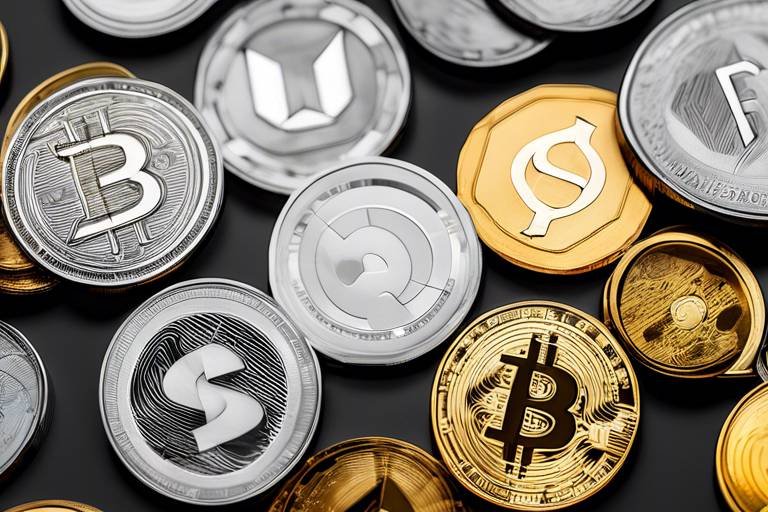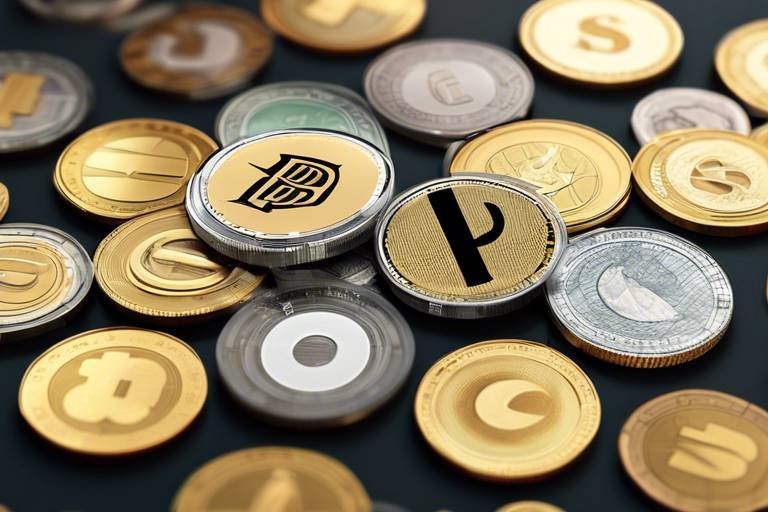Understanding the Different Types of Crypto Tokens
In the ever-evolving landscape of digital finance, crypto tokens have emerged as a pivotal element, transforming how we perceive value and ownership. But what exactly are these tokens? Think of them as digital assets that exist on a blockchain, each serving a unique purpose within its ecosystem. Just like different types of currency serve various functions in our economy, crypto tokens come in various forms, each with its own set of characteristics and uses. Understanding these distinctions is crucial for anyone looking to navigate the complex world of cryptocurrencies.
At their core, crypto tokens can be categorized into several types, each playing a distinct role in the blockchain ecosystem. From utility tokens that offer access to specific services, to security tokens that represent ownership in real-world assets, the diversity is astounding. Moreover, the rise of stablecoins has added another layer of complexity, providing a bridge between the volatile world of cryptocurrencies and the stability of traditional fiat currencies. In this article, we will delve into these categories, exploring their unique characteristics, legal implications, and the challenges they face in today’s digital economy.
As we journey through the different types of tokens, we will also uncover how they interact with one another and their significance in the broader context of blockchain technology. Are you ready to embark on this enlightening exploration? Let’s dive deeper into the fascinating world of crypto tokens!
Utility tokens are like the keys to a digital kingdom, granting holders access to a product or service within a specific blockchain ecosystem. Imagine you’re at a concert; your ticket (utility token) allows you access to the event, but it doesn’t hold any value beyond that experience. These tokens are crucial for projects that operate on a decentralized platform, as they incentivize users to engage with the network.
Investors often evaluate the potential of utility tokens by examining the underlying project’s roadmap, community engagement, and technological innovations. Understanding their role can help you gauge a project’s long-term viability. For instance, a utility token might be used to pay for transaction fees, access premium features, or even participate in governance decisions. This multifaceted functionality makes them an integral part of the blockchain ecosystem.
On the other end of the spectrum, we have security tokens, which represent ownership in an asset or a company. Unlike utility tokens, security tokens are regulated by securities laws, ensuring that they meet specific legal requirements. This regulation adds a layer of legitimacy but also introduces complexities that can deter some investors. Think of security tokens as stocks in the digital realm; they allow investors to own a piece of a company and potentially earn dividends.
Regulatory compliance is a crucial aspect of security tokens. It ensures that these tokens adhere to legal frameworks, protecting investors and maintaining market integrity. The importance of compliance cannot be overstated, as failing to meet these requirements can lead to significant penalties and a loss of investor trust. This section will discuss how companies navigate these regulations and the implications for token issuance.
Security tokens offer several compelling benefits, including fractional ownership and increased liquidity. Fractional ownership allows investors to buy a fraction of an asset, making high-value investments more accessible. Increased liquidity means that these tokens can be traded on various exchanges, providing investors with more opportunities to buy and sell. This can lead to a more dynamic market, attracting a broader range of investors.
Despite their potential, security tokens face several challenges, including regulatory hurdles and market acceptance. The regulatory landscape is still evolving, and many jurisdictions have yet to establish clear guidelines. Additionally, convincing traditional investors to embrace this new asset class can be a tough sell. This part will examine the obstacles that could hinder the growth of security tokens in the financial landscape.
Tokenization is the process of converting physical assets into digital tokens on a blockchain. This innovative approach enhances asset liquidity and accessibility for investors. Imagine owning a piece of real estate, but instead of dealing with all the complexities of property management, you simply hold a token that represents your ownership. This not only simplifies transactions but also opens up investment opportunities to a broader audience.
Stablecoins are designed to maintain a stable value, typically pegged to a fiat currency like the US dollar. They act as a safe haven in the often volatile crypto market, providing a reliable means of transaction. Think of stablecoins as the calm in the storm; they allow traders to move in and out of positions without the fear of sudden price fluctuations. This stability is essential for facilitating transactions and maintaining trust in the cryptocurrency ecosystem.
There are various types of stablecoins, including:
- Fiat-Collateralized: Backed by fiat currency held in reserve.
- Crypto-Collateralized: Backed by other cryptocurrencies, often over-collateralized to manage volatility.
- Algorithmic: Uses algorithms to control supply and demand, maintaining price stability.
Stablecoins serve multiple purposes within the cryptocurrency ecosystem. They can facilitate trading, act as a hedge against volatility, and even provide a means for remittances. By offering a stable value, they allow users to transact with confidence, knowing that their purchasing power won’t suddenly evaporate. This section will discuss the practical applications of stablecoins and how they are reshaping the way we think about digital currency.
What are crypto tokens?
Crypto tokens are digital assets that exist on a blockchain, each serving a unique purpose within its ecosystem.
What is the difference between utility tokens and security tokens?
Utility tokens grant access to a product or service, while security tokens represent ownership in an asset and are regulated by securities laws.
Why are stablecoins important?
Stablecoins maintain a stable value, providing a reliable means of transaction in the volatile crypto market.

Utility Tokens
are a fascinating component of the blockchain ecosystem. They serve specific functions and provide holders with access to a product or service within a particular platform. Imagine walking into a digital store where the only currency accepted is a special type of token that grants you access to exclusive features or services. That’s the essence of utility tokens! They are not just digital coins; they are keys that unlock various functionalities within a decentralized network.
These tokens are often issued during Initial Coin Offerings (ICOs) or token sales, where investors can purchase them in exchange for cryptocurrencies like Bitcoin or Ethereum. For instance, a gaming platform might issue utility tokens that allow players to buy in-game items, access premium features, or even participate in governance decisions within the game. This creates a direct relationship between the token and the service it provides, making it a vital part of the ecosystem.
One of the most exciting aspects of utility tokens is their potential for investment opportunities. As demand for the associated service or product grows, so does the value of the token. However, it’s essential for investors to conduct thorough research before diving in. Understanding the project’s roadmap, the team behind it, and the overall market demand can significantly influence the success of the investment.
Utility tokens can be categorized into different types based on their functionality. Here are a few examples:
- Access Tokens: These tokens provide users with access to a specific service or platform.
- Governance Tokens: Holders of these tokens can vote on decisions affecting the platform’s future.
- Incentive Tokens: These are used to reward users for participating in the network, like completing tasks or contributing content.
To illustrate the significance of utility tokens, let’s take a look at a simple comparison table:
| Type of Utility Token | Function | Example |
|---|---|---|
| Access Token | Grants access to a service | Filecoin (for decentralized storage) |
| Governance Token | Allows voting on platform decisions | MakerDAO (for governance in the DAI ecosystem) |
| Incentive Token | Rewards user contributions | Steemit (for content creation and curation) |
In conclusion, utility tokens play a critical role in the blockchain landscape. They not only facilitate various functionalities within their respective ecosystems but also create opportunities for investment and participation. As the crypto world continues to evolve, understanding the dynamics of utility tokens becomes increasingly important for investors and users alike. So, next time you hear about a new token, ask yourself: what utility does it offer?

Security Tokens
Security tokens are a revolutionary concept in the cryptocurrency landscape, representing ownership in an asset or a company. Unlike utility tokens, which provide access to specific services or products within a blockchain ecosystem, security tokens are regulated by securities laws. This regulatory oversight adds a layer of legitimacy and protection for investors, making security tokens an enticing option for those looking to invest in the digital economy.
One of the key features of security tokens is their ability to represent real-world assets. Imagine owning a piece of real estate or a share in a startup, but instead of dealing with cumbersome paperwork and middlemen, you can simply hold a digital token that signifies your ownership. This streamlined process not only enhances transparency but also reduces transaction costs, making it easier for investors to participate in various markets.
However, navigating the world of security tokens requires an understanding of the legal implications involved. Since these tokens fall under the purview of securities regulations, companies must comply with stringent requirements before they can issue security tokens. This includes filing necessary documentation and ensuring that investors are accredited or qualified. The importance of regulatory compliance cannot be overstated, as it protects both the issuer and the investor from potential legal issues down the line.
When it comes to security tokens, regulatory compliance is not just a box to check; it’s a fundamental aspect of their existence. The legal framework surrounding security tokens varies by jurisdiction, but the overarching goal remains the same: to protect investors and maintain market integrity. Companies that fail to adhere to these regulations risk facing hefty fines, legal battles, and loss of credibility in the market. Thus, understanding the regulatory landscape is crucial for both issuers and investors.
Security tokens come with a plethora of benefits that make them attractive to investors. Among these advantages are:
- Fractional Ownership: Security tokens allow investors to own a fraction of an asset, making high-value investments more accessible.
- Increased Liquidity: By tokenizing assets, security tokens can be traded on various platforms, enhancing liquidity compared to traditional assets.
- Transparency: The use of blockchain technology ensures that all transactions are recorded and transparent, reducing the risk of fraud.
These benefits not only make security tokens appealing but also serve to attract a broader range of investors, enhancing overall market participation.
Despite their promising potential, security tokens are not without challenges. Regulatory hurdles can be daunting, with companies often facing a complicated maze of legal requirements. Additionally, market acceptance remains a significant obstacle, as many investors are still unfamiliar with the concept of security tokens and may be hesitant to invest. The path to widespread adoption is fraught with challenges, but understanding these issues is the first step towards overcoming them.
Tokenization is the process of converting physical assets into digital tokens on a blockchain. This innovative approach enhances asset liquidity and accessibility for investors. By transforming tangible assets like real estate, art, or even stocks into security tokens, investors can trade them easily on various platforms. This not only democratizes access to investment opportunities but also opens up new avenues for raising capital.

Regulatory Compliance
When we talk about security tokens, one of the most critical aspects that come into play is . This is not just a box to check; it's the backbone that ensures these tokens operate within the legal framework established by governments and financial authorities. Think of it as the rules of the game that everyone must follow to keep things fair and transparent. Without adhering to these regulations, security tokens risk being classified as illegal securities, which could lead to hefty fines or even a complete shutdown of the project.
So, what does regulatory compliance mean in the world of security tokens? Essentially, it involves meeting the legal requirements set forth by various regulatory bodies. This can include registering the tokens with the appropriate authorities, providing disclosures to potential investors, and ensuring that the offering is conducted in a compliant manner. For instance, in the United States, the Securities and Exchange Commission (SEC) plays a pivotal role in overseeing these activities, and any company looking to issue security tokens must navigate this complex landscape.
Moreover, the importance of regulatory compliance cannot be overstated. It not only protects investors but also enhances the credibility of the project. Imagine investing in a token that has no regulatory backing—it's like sailing a ship without a compass. You might end up lost at sea, with no clear direction or safety net. By adhering to regulations, companies can build trust with their investors, which is crucial for long-term success.
However, achieving compliance is not without its challenges. The regulatory landscape is constantly evolving, and what might be compliant today could change tomorrow. This dynamic nature of regulations can make it difficult for companies to keep up. They must stay informed about the latest laws and guidelines, which can vary significantly from one jurisdiction to another. For example, a token that meets compliance standards in Europe may not necessarily meet those in Asia or North America.
To give you a clearer picture, here’s a quick breakdown of some key compliance elements that companies must consider:
- Know Your Customer (KYC): This process involves verifying the identity of investors to prevent fraud and money laundering.
- Anti-Money Laundering (AML): Companies must have measures in place to detect and report suspicious activities.
- Disclosure Requirements: Issuers need to provide potential investors with all necessary information about the token and the associated risks.
In conclusion, regulatory compliance is not just a legal obligation; it is a vital component that can determine the success or failure of a security token offering. By understanding and implementing these regulations, companies can not only protect themselves from legal repercussions but also foster a sense of trust and security among their investors. As the blockchain landscape continues to evolve, staying ahead of the regulatory curve will be essential for any project aiming to thrive in this competitive environment.

Benefits of Security Tokens
Security tokens are gaining traction in the world of finance, and for good reason! They come with a plethora of benefits that make them an attractive option for both investors and companies alike. One of the most significant advantages is fractional ownership. Unlike traditional assets, security tokens allow investors to own a fraction of an asset, making high-value investments accessible to a broader audience. Imagine being able to own a slice of a luxury real estate property or a piece of a thriving startup without having to spend a fortune. This democratization of investment opportunities is a game-changer!
Another remarkable benefit of security tokens is their increased liquidity. Traditional assets often take time to sell, but security tokens can be traded on various exchanges, allowing investors to buy and sell them much more quickly. This liquidity not only enhances market participation but also provides a safety net for investors who may need to access their funds rapidly. Think of it as having a backup parachute; it gives you peace of mind knowing you can make a swift exit if necessary.
Moreover, security tokens are regulated by securities laws, which adds a layer of protection for investors. This regulation ensures that the companies issuing these tokens are held to a standard, providing transparency and accountability. Investors can feel more secure knowing they are participating in a system that has legal backing. In a world where scams and fraudulent schemes can run rampant, this assurance is invaluable.
Security tokens also facilitate global investment opportunities. With the blockchain technology behind them, investors from different parts of the world can easily access and invest in various assets, breaking down geographical barriers that once limited investment options. Imagine being able to invest in a tech startup in Silicon Valley while sitting in a coffee shop in Paris! This global accessibility opens up a world of possibilities and diversifies investment portfolios.
In summary, the benefits of security tokens are numerous and impactful. From fractional ownership to increased liquidity and regulatory compliance, they provide a modern solution to traditional investment challenges. As the market continues to evolve, these advantages are likely to attract more investors, further solidifying the role of security tokens in the financial landscape.
- What are security tokens? Security tokens are digital representations of ownership in an asset or company, regulated by securities laws.
- How do security tokens differ from utility tokens? Unlike utility tokens, which provide access to a product or service, security tokens represent ownership and are subject to regulatory compliance.
- What are the advantages of investing in security tokens? They offer fractional ownership, increased liquidity, regulatory protection, and global investment opportunities.
- Are security tokens safe investments? While they are regulated, like all investments, they carry risks. It's essential to conduct thorough research before investing.

Challenges Faced
Despite the promising landscape for security tokens, several challenges loom large, creating a complex environment for both issuers and investors. One of the most significant hurdles is navigating the intricate web of regulatory compliance. Security tokens, by their very nature, are subject to strict regulations that vary from country to country. This can create uncertainty for projects looking to launch their tokens, as they must ensure they meet all legal requirements to avoid hefty fines or even legal action. The lack of a universal regulatory framework can stifle innovation and slow down the adoption of security tokens.
Another major challenge is market acceptance. While the concept of security tokens is gaining traction, many investors remain skeptical. They often question the legitimacy and security of these tokens compared to traditional investment vehicles. This skepticism can be attributed to a general lack of understanding of how security tokens operate and their potential benefits. Furthermore, the market is still relatively new, and many participants are hesitant to invest in something that feels untested.
Moreover, the technology underlying security tokens, including blockchain and smart contracts, is still evolving. While these technologies promise enhanced security and transparency, they also come with their own set of risks. For instance, bugs in smart contracts can lead to vulnerabilities that hackers might exploit, resulting in significant financial losses. Investors and issuers alike must remain vigilant and ensure that proper security measures are in place.
In addition to these challenges, there is also the issue of liquidity. Many security tokens are not easily tradable on exchanges, which can deter potential investors. The lack of liquidity can lead to price volatility and make it difficult for investors to exit their positions. This is particularly concerning for those looking to invest in security tokens as a way to diversify their portfolios.
Lastly, there is a need for education within the market. Many potential investors are still unaware of what security tokens are and how they differ from utility tokens and other cryptocurrencies. Without adequate education and resources, it becomes even more challenging to foster a healthy market environment. To overcome these obstacles, stakeholders in the security token space must work together to provide clarity, build trust, and promote understanding among investors.
In summary, while security tokens hold immense potential, they are not without their challenges. The path forward will require collaboration, innovation, and a commitment to regulatory compliance to ensure that these digital assets can thrive in the financial landscape.
- What are security tokens? Security tokens are digital representations of ownership in an asset or company that are regulated by securities laws.
- What challenges do security tokens face? Security tokens face challenges such as regulatory compliance, market acceptance, liquidity issues, and the need for investor education.
- How do security tokens differ from utility tokens? Unlike utility tokens, which provide access to a service or product, security tokens represent ownership and are subject to securities regulations.
- What is the importance of regulatory compliance for security tokens? Regulatory compliance ensures that security tokens meet legal requirements, which is crucial for their legitimacy and acceptance in the market.

Tokenization of Assets
Tokenization is a revolutionary process that transforms traditional physical assets into digital tokens on a blockchain. Imagine taking a tangible item, like a piece of art, real estate, or even a vintage car, and creating a unique digital representation of it that can be traded, owned, or sold. This process not only enhances the liquidity of these assets but also opens up investment opportunities to a broader audience. By breaking down an asset into smaller, more affordable tokens, investors can buy fractions of high-value items, making it easier for them to diversify their portfolios.
One of the most exciting aspects of tokenization is its ability to democratize access to investment opportunities. In the traditional financial world, investing in real estate or fine art often requires substantial capital and comes with various barriers. However, with tokenization, anyone can invest in a fraction of a property or artwork, thus lowering the entry threshold. This shift could lead to a more inclusive financial ecosystem, where more individuals can participate in investments that were once reserved for the wealthy.
Moreover, tokenization provides a streamlined and efficient way to transfer ownership. The use of smart contracts on the blockchain automates the process, reducing the time and costs associated with traditional transactions. For instance, when a token representing a real estate property is sold, the smart contract can automatically execute the transfer of ownership, ensuring that both parties fulfill their obligations without the need for intermediaries. This not only speeds up transactions but also enhances security and transparency.
However, the tokenization of assets is not without its challenges. Regulatory compliance is a significant concern, as the legal framework surrounding tokenized assets is still evolving. Different jurisdictions have varying rules regarding the ownership and transfer of digital tokens, which can complicate international transactions. Furthermore, the technology itself must be robust enough to ensure that the tokens accurately represent the underlying assets and that all transactions are securely recorded on the blockchain.
In summary, the tokenization of assets represents a paradigm shift in how we think about ownership and investment. By converting physical assets into digital tokens, we not only enhance liquidity and accessibility but also pave the way for a more inclusive financial landscape. As technology continues to evolve and regulatory frameworks adapt, the potential for tokenized assets is boundless, promising to reshape the future of investing.
- What is tokenization? Tokenization is the process of converting physical assets into digital tokens on a blockchain, enabling easier trading and ownership transfer.
- How does tokenization enhance liquidity? By breaking down assets into smaller, tradable tokens, it allows more investors to participate, thus increasing market activity and liquidity.
- Are tokenized assets secure? Yes, tokenized assets are secured using blockchain technology, which provides transparency and immutability, making it difficult to alter transaction records.
- What are the regulatory concerns with tokenization? Regulatory compliance varies by jurisdiction, and the evolving legal landscape can pose challenges for the acceptance and trading of tokenized assets.

Stablecoins
Stablecoins are a fascinating subset of the cryptocurrency world, designed to maintain a stable value over time. Unlike the notorious volatility of traditional cryptocurrencies like Bitcoin or Ethereum, stablecoins aim to provide a predictable and reliable digital currency experience. Typically, they are pegged to a fiat currency, such as the US dollar, which helps them retain their value even amidst the wild fluctuations of the crypto market. Imagine having a digital dollar that you can use for transactions without worrying about whether its value will drop by 20% overnight. That’s the beauty of stablecoins!
One of the primary reasons stablecoins have gained traction is their utility in the cryptocurrency ecosystem. They serve as a bridge between traditional finance and the crypto world. For instance, when traders want to exit a volatile position, they can easily convert their assets into stablecoins to preserve their value. This capability not only enhances liquidity but also provides a safe haven during turbulent market conditions. Think of stablecoins as a life raft in the stormy sea of cryptocurrency trading.
Stablecoins can be categorized into three main types, each with its unique mechanism for maintaining stability. These include:
- Fiat-Collateralized Stablecoins: These are backed 1:1 by a fiat currency, meaning for every stablecoin issued, there is an equivalent amount of fiat currency held in reserve. Tether (USDT) and USD Coin (USDC) are prime examples.
- Crypto-Collateralized Stablecoins: These stablecoins are backed by other cryptocurrencies. They often use smart contracts to maintain their value, but they can be more volatile than fiat-backed options. DAI is a notable example of this type.
- Algorithmic Stablecoins: Instead of being backed by collateral, these stablecoins use algorithms to control their supply and demand. They attempt to maintain a stable price through market mechanisms. Examples include TerraUSD (UST).
Understanding these categories can help investors make informed decisions when navigating the crypto landscape. But what are the practical applications of stablecoins? They serve multiple purposes, such as:
- Facilitating trading on cryptocurrency exchanges.
- Acting as a hedge against market volatility.
- Providing a means for remittances and cross-border payments.
In summary, stablecoins play a crucial role in the digital economy by offering a stable medium of exchange and a store of value. They bridge the gap between traditional finance and the rapidly evolving world of cryptocurrencies, making them an essential tool for traders, investors, and everyday users alike.
What are stablecoins?
Stablecoins are cryptocurrencies designed to maintain a stable value, often pegged to a fiat currency like the US dollar.
How do stablecoins work?
They work by being backed by reserves of fiat currency, other cryptocurrencies, or through algorithms that manage supply and demand.
Why are stablecoins important?
Stablecoins provide stability in the volatile crypto market, allowing users to transact without the fear of drastic price changes.
Can stablecoins be used for trading?
Absolutely! They are widely used on exchanges for trading and can also be used for remittances and other financial transactions.

Types of Stablecoins
Stablecoins have emerged as a crucial component of the cryptocurrency landscape, designed to provide stability in an otherwise volatile market. They are typically pegged to a fiat currency, such as the US dollar, or other assets, ensuring that their value remains relatively constant. However, not all stablecoins are created equal, and they can be categorized into several types based on their underlying mechanisms. Understanding these types is essential for anyone looking to navigate the crypto market effectively.
There are three primary categories of stablecoins: fiat-collateralized, crypto-collateralized, and algorithmic stablecoins. Each type has its unique characteristics and operational mechanisms that serve different purposes within the ecosystem.
| Type of Stablecoin | Description | Examples |
|---|---|---|
| Fiat-Collateralized | These stablecoins are backed by a reserve of fiat currency, usually held in a bank account. For every stablecoin issued, an equivalent amount of fiat currency is kept in reserve, ensuring that the stablecoin can be redeemed for its pegged value. | Tether (USDT), USD Coin (USDC) |
| Crypto-Collateralized | Crypto-collateralized stablecoins are backed by other cryptocurrencies. To account for the volatility of the collateral, these stablecoins are often over-collateralized, meaning that more cryptocurrency is held in reserve than the value of the stablecoins issued. | DAI, sUSD |
| Algorithmic Stablecoins | Unlike the previous types, algorithmic stablecoins are not backed by any collateral. Instead, they use algorithms to control the supply of the coin, increasing or decreasing it based on demand to maintain a stable price. | Ampleforth (AMPL), TerraUSD (UST) |
Fiat-collateralized stablecoins are the most straightforward and widely used. They offer the reassurance of being backed by real-world assets, making them appealing to both investors and traders. However, the trustworthiness of these stablecoins heavily relies on the transparency and integrity of the institutions managing the reserves. On the other hand, crypto-collateralized stablecoins provide an interesting twist by leveraging the very assets that contribute to the volatility of the crypto market. This can be a double-edged sword, as the value of the collateral can fluctuate, potentially leading to liquidation events if the value drops too low.
Algorithmic stablecoins represent a more innovative approach, relying on sophisticated algorithms to manage supply and demand. While they can offer exciting possibilities for maintaining stability, they also carry inherent risks, especially during extreme market conditions when the algorithms may struggle to maintain the peg. This unpredictability can lead to significant price fluctuations, which is the opposite of what stablecoins aim to achieve.
In conclusion, understanding the different types of stablecoins is vital for anyone interested in the cryptocurrency market. Each type has its strengths and weaknesses, and the choice of which stablecoin to use can greatly depend on the specific needs and risk tolerance of the user. As the crypto landscape continues to evolve, stablecoins will likely play an increasingly important role in bridging the gap between traditional finance and the digital economy.
- What is a stablecoin? A stablecoin is a type of cryptocurrency designed to maintain a stable value, typically pegged to a fiat currency or other assets.
- How are stablecoins different from other cryptocurrencies? Unlike traditional cryptocurrencies that can be highly volatile, stablecoins aim to provide price stability, making them more suitable for everyday transactions.
- Can stablecoins be used for trading? Yes, stablecoins are often used as trading pairs on exchanges, allowing traders to move in and out of positions without needing to convert back to fiat currency.
- Are stablecoins safe to use? The safety of stablecoins depends on their underlying structure and the transparency of the reserves backing them. It's essential to research and choose reputable stablecoins.

Use Cases for Stablecoins
Stablecoins have carved out a significant niche in the cryptocurrency ecosystem, acting as a bridge between the volatile world of digital assets and the stability of traditional fiat currencies. One of the most compelling use cases for stablecoins is their role in facilitating trading. Traders often use stablecoins to quickly move in and out of positions without having to convert back to fiat currency. This capability allows for greater flexibility and speed in executing trades, which can be crucial in the fast-paced crypto markets.
Moreover, stablecoins serve as a hedge against market volatility. In times of market turmoil, investors can convert their assets into stablecoins to preserve their value. This function is akin to using cash in a traditional market; it allows investors to sidestep the wild price swings that can occur with other cryptocurrencies. By holding stablecoins, investors can maintain liquidity while waiting for a more favorable market condition to re-enter their preferred assets.
Another exciting application of stablecoins is in decentralized finance (DeFi). Many DeFi platforms utilize stablecoins as collateral for loans or as a medium for yield farming. For instance, users can deposit stablecoins into a liquidity pool and earn interest, often at rates significantly higher than traditional banks offer. This not only enhances the earning potential for users but also increases the overall liquidity within the DeFi ecosystem.
Furthermore, stablecoins are increasingly being adopted for remittances and cross-border payments. Traditional remittance services can be costly and slow, often taking days to process. In contrast, stablecoins can facilitate near-instantaneous transactions at a fraction of the cost. This is particularly beneficial for individuals in developing countries who rely on remittances from abroad. With stablecoins, they can receive funds quickly and securely, enabling them to access their money without unnecessary delays or fees.
Lastly, stablecoins can also play a pivotal role in smart contracts. By incorporating stablecoins into smart contracts, developers can create applications that require stable value transactions. This integration allows for a variety of use cases, from automated payments to complex financial agreements, all while mitigating the risk associated with price fluctuations. The ability to program stablecoins into smart contracts opens up a world of possibilities for developers and users alike.
In summary, stablecoins are not just a tool for trading; they are versatile assets that enhance liquidity, facilitate cross-border transactions, and provide a stable medium for various financial applications. As the cryptocurrency landscape continues to evolve, the importance of stablecoins is likely to grow, making them a crucial component of the digital economy.
- What are stablecoins? Stablecoins are cryptocurrencies that are designed to maintain a stable value, typically by being pegged to a fiat currency.
- How do stablecoins work? Stablecoins work by using various mechanisms, such as collateralization or algorithms, to ensure their value remains stable.
- What are the benefits of using stablecoins? Benefits include reduced volatility, faster transactions, and lower fees compared to traditional banking systems.
- Can stablecoins be used for trading? Yes, stablecoins are commonly used for trading as they allow for quick conversions and provide a stable value during volatile market conditions.
- Are stablecoins regulated? The regulatory landscape for stablecoins is still evolving, with various jurisdictions implementing different rules and guidelines.
Frequently Asked Questions
- What are utility tokens?
Utility tokens are a type of cryptocurrency that provide users with access to a product or service within a specific blockchain ecosystem. They typically serve a functional purpose, allowing holders to participate in the network or use its services. For example, a utility token might be used to pay for transaction fees or access certain features of a platform.
- How do security tokens differ from utility tokens?
Security tokens represent ownership in an asset, such as equity in a company or a share of real estate. Unlike utility tokens, which are primarily used for access or services, security tokens are subject to securities regulations and provide holders with certain rights, such as dividends or voting power. This regulatory framework adds a layer of protection for investors.
- What is the significance of regulatory compliance for security tokens?
Regulatory compliance is crucial for security tokens as it ensures they adhere to legal requirements set forth by authorities. This compliance not only protects investors but also enhances the legitimacy of the token in the market. Failure to comply can result in legal penalties and loss of investor trust, which can hinder the growth of the project.
- What are the benefits of security tokens?
Security tokens offer several advantages, including fractional ownership, which allows investors to own a small part of a larger asset, and increased liquidity, making it easier to buy and sell these tokens in the market. These features can attract a broader range of investors and enhance participation in the financial ecosystem.
- What challenges do security tokens face?
Despite their potential, security tokens encounter challenges such as navigating complex regulatory landscapes and gaining market acceptance. These hurdles can slow down their adoption and limit their effectiveness as a financial instrument, making it essential for issuers to strategize effectively.
- What is tokenization of assets?
Tokenization of assets refers to the process of converting physical assets, like real estate or art, into digital tokens on a blockchain. This transformation enhances liquidity and accessibility, allowing a broader range of investors to participate in markets that were previously difficult to access.
- What are stablecoins and why are they important?
Stablecoins are cryptocurrencies designed to maintain a stable value, often pegged to a fiat currency like the US dollar. They play a vital role in the crypto market by providing a stable medium of exchange, making transactions smoother and less volatile, which is especially useful for trading and remittances.
- What types of stablecoins exist?
There are three main types of stablecoins: fiat-collateralized, crypto-collateralized, and algorithmic. Fiat-collateralized stablecoins are backed by reserves of fiat currency, while crypto-collateralized stablecoins are backed by other cryptocurrencies. Algorithmic stablecoins use algorithms to control supply and demand, maintaining their value without collateral.
- What are the use cases for stablecoins?
Stablecoins serve various purposes in the cryptocurrency ecosystem, including facilitating trading, acting as a hedge against market volatility, and providing a reliable means of transferring value. Their stability makes them an attractive option for users looking to avoid the unpredictable swings often seen in other cryptocurrencies.



















